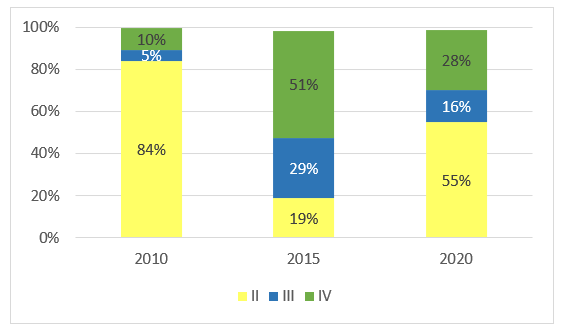Economic and environmental impacts of stacked transgenic events on soybean and corn
DOI:
https://doi.org/10.31285/AGRO.29.1323Keywords:
transgenic events, costs, productivity, environmental impact, agrochemicalsAbstract
Between 1996 and 2020, the Uruguayan government authorized twenty-eight genetically modified varieties of corn and soybean. This study investigates if the transgenic seed with stacked events with more than one agronomic characteristic in soybean and corn (HT and Bt), compared to those of one event (HT or Bt), shows productive, economic and environmental advantages in the period between 2010 and 2020 in Uruguay. To achieve the proposed objectives, a partial budgeting method was developed for the economic analysis. In addition, the mean difference for soybean yields was estimated with the “Bootstrap” and “Anova” techniques. The consumption of herbicides and insecticides in trans-genic soybean and maize crops was estimated, comparing it with national imports. Toxicity indices for mammals, bees and chemical persistence in soil were constructed with the evolution of the main herbicides and insecticides according to toxicological category applied to soybean and corn crops. Finally, the number of insecticide applications entrances to field was also weighted and then validated through the Poisson technique. Results showed economic advantages, mainly for corn crops with three stacked events. While the soybean varieties with stacked events did not have differences in yield, a decrease in the entries to field due to insecticide applications was observed, which does not compensate for the higher cost of the seed. The results obtained showed a general improvement in the evolution of less toxic insecticides for mammals and bees, but with an increase in applications with non-glyphosate herbicides.
Downloads
References
Aramburu F, Monzón JP, Mercau J, Taboada M, Andrade F, Hall A, Jobbagy E, Cassman K, Grassini P. Potential for crop production increase in Argentina through closure of existing yield gaps. Field Crops Res. 2015;184:145-54. Doi: 10.1016/j.fcr.2015.10.001. DOI: https://doi.org/10.1016/j.fcr.2015.10.001
Bianco M. El valor de la semilla: propiedad intelectual y acumulación capitalista. Rev Cienc Soc. 2015;28(36):37-54.
Bravo E. Los cultivos transgénicos en América Latina. In: Manzur M, Cárcamo M, editors. América Latina: La transgénesis de un continente: visión crítica de una expansión descontrolada. Rio de Janeiro: Fundación Heinrich Böll; 2014. p. 8-17.
Burger M, Bajsa N, Evia V, Artía P, Bandeira E, Taroco L, Rosano L, Rama P, Franco Fraguas L, Toledo S, Galeano P, Galván G, Cauci A, Martínez Debat C, Oyhantçabal G, Narbondo I, Barcia M. Cultivos transgénicos en Uruguay: aportes para la comprensión de un tema complejo [Internet]. Montevideo: Udelar; 2017 [cited 2024 Nov 04]. Available from: https://www.colibri.udelar.edu.uy/jspui/handle/20.500.12008/32798
Caceres D. Biotecnología y poder: ¿Usan los cultivos transgénicos menos agroquímicos? Rev Interdiscipl Est Agr. 2018;48:29-56.
CIMMYT. La formulación de recomendaciones a partir de datos agronómicos: un manual metodológico de evaluación económica. México: CIMMYT; 1988. 79p.
Coelho Carvalho L. Análisis económica da producao de soja RR2 PRO e soja RR1: estudo de caso no Estado de Mato Grosso [master’s thesis on Internet]. Botucatu (BR): Universidade Estadual Paulista, Faculdade de Ciencias Agronomicas; 2015 [cited 2024 Nov 04]. Available from: https://repositorio.unesp.br/handle/11449/126615
Fernandes FO, da Rosa APA, de Abreu JÁ, Christ LM, Belarmino LC, da Silva Martins JF. Performance of soybean cultivars in integrated pest management in lowland agroecosystem. Rev Bras Cienc Agrar. 2020;15(1):e5726. Doi: 10.5039/agraria.v15i1a5726. DOI: https://doi.org/10.5039/agraria.v15i1a5726
Horikoshi RJ, Dourado PM, Berger GU, de S Fernandes D, Omoto C, Willse A, Martinelli S, Head GP, Corrêa AS. Large-scale assessment of lepidopteran soybean pests and efficacy of Cry1Ac soybean in Brazil. Sci Rep. 2021;11(1):15956. Doi: 10.1038/s41598-021-95483-9. DOI: https://doi.org/10.1038/s41598-021-95483-9
INASE. Resultados ENC [Internet]. Montevideo: INASE; [cited 2024 Nov 04]. Available from: https://www.inase.uy/Publicaciones/Publicaciones.aspx?s=dt-enc
Kahl MB. Principales características de los insecticidas utilizados en el cultivo de soja. Serie Extensión Digital, Segundo Trimestre. 2013;5:31-50.
Klumper W, Qaim M. A meta-analysis of the impacts of genetically modified crops. PlosOne. 2014;9(11):e111629. Doi: 10.1371/journal.pone.0111629. DOI: https://doi.org/10.1371/journal.pone.0111629
Marques LH, Santos AC, Castro BA, Moscardini VF, Rosseto J, Silva OABN, Babcock JM. Assessing the efficacy of Bacillus thuringiensis (Bt) Pyramided Proteins Cry1F, Cry1A.105, Cry2Ab2, and Vip3Aa20 Expressed in Bt maize against Lepidopteran pests in Brazil. J Econ Entomol. 2019;112(2):803-11. Doi: 10.1093/jee/toy380. DOI: https://doi.org/10.1093/jee/toy380
Massoni FA, Frana JE, Trossero M. Evaluación del daño de lepidópteros en híbridos de maíz Bt (Maízgard, Hérculex, VT Triple Pro, Powercore, Agrisure Viptera 3), y determinación del impacto sobre el rendimiento [Internet]. Rafaela: EEA INTA; 2015 [cited 2024 Nov 04]. Available from: https://www.engormix.com/agricultura/enfermedad-plaga-maiz/evaluacion-dano-lepidopteros-hibridos_a32667/
Massoni FA, Schlie G, Frana JE. Cultivo de soja Bt (RR2 PRO) y convencional (RR1) expuestos a poblaciones naturales de organismos plaga y depredadores [Internet]. Rafaela: EEA INTA; 2015 [cited 2024 Nov 04]. Available from: https://www.engormix.com/agricultura/biotecnologia/cultivo-soja-rr2-pro_a32447/
Ministerio de Ganadería, Agricultura y Pesca, DGSA (UY). Importaciones de productos fitosanitarios [Internet]. Montevideo: MGAP; [cited 2024 Nov 04]. Available from: https://www.gub.uy/ministerio-ganaderia-agricultura-pesca/datos-y-estadisticas/datos/importaciones-productos-fitosanitarios
Perez D, Devani M, Ledesma F, Paredes V, Rodríguez G. Costo del control de plagas (insectos y malezas) y de la incorporación de la tecnología Intacta en el cultivo de soja en Tucumán, en la campaña 2013/2014. Revista Avance Agroindustrial. 2015;35(3):17-21.
Pirchio BA, Fernández Madrid S, Baudino SM, Corro Molas A. Efecto de distintos eventos biotecnológicos de maíz en el consumo y mortalidad de la “oruga cortadora áspera” (Agrotis robusta). Semiárida. 2019;29(2):43-50. Doi: 10.19137/semiarida.2019(02).43-50. DOI: https://doi.org/10.19137/semiarida.2019(02).43-50
República Oriental del Uruguay, Presidencia. Decreto N° 482/009 [Internet]. 2009 [cited 2024 Nov 04]. Available from: https://www.gub.uy/presidencia/institucional/normativa/decreto-482009
Rizzo G, Monzón JP, Ernst O. Cropping system-imposed yield gap: proof of concept on soybean cropping systems in Uruguay. Field Crops Res. 2021;260:107944. Doi: 10.1016/j.fcr.2020.107944. DOI: https://doi.org/10.1016/j.fcr.2020.107944
Santos DJ, Saluso A. ¿Rinden más los cultivares de soja con tecnología Intacta RR2 PRO? Serie Extensión INTA Paraná [Internet]. 2020 [cited 2024 Nov 04] (86):19-24. Available from: https://repositorio.inta.gob.ar/bitstream/handle/20.500.12123/8204/INTA_CREntreRios_EEAParana_Santos_DJ_rendimiento_de_soja_con_tecnologia_intacta_-santos_saluso-_2020.pdf?sequence=1&isAllowed=y

Downloads
Published
How to Cite
Issue
Section
License
Copyright (c) 2025 Agrociencia Uruguay

This work is licensed under a Creative Commons Attribution 4.0 International License.
| Article metrics | |
|---|---|
| Abstract views | |
| Galley vies | |
| PDF Views | |
| HTML views | |
| Other views | |

















